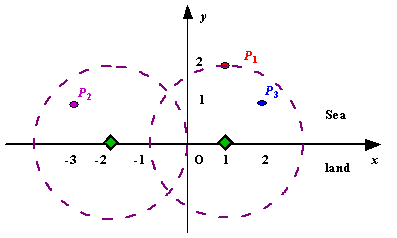Problem Description
Assume the coasting is an infinite straight line. Land is in one side of coasting, sea in the other. Each small island is a point locating in the sea side. And any radar installation, locating on the coasting, can only cover d distance,
so an island in the sea can be covered by a radius installation, if the distance between them is at most d.
We use Cartesian coordinate system, defining the coasting is the x-axis. The sea side is above x-axis, and the land side below. Given the position of each island in the sea, and given the distance of the coverage of the radar installation, your task is to write a program to find the minimal number of radar installations to cover all the islands. Note that the position of an island is represented by its x-y coordinates.

Figure A Sample Input of Radar Installations
We use Cartesian coordinate system, defining the coasting is the x-axis. The sea side is above x-axis, and the land side below. Given the position of each island in the sea, and given the distance of the coverage of the radar installation, your task is to write a program to find the minimal number of radar installations to cover all the islands. Note that the position of an island is represented by its x-y coordinates.

Figure A Sample Input of Radar Installations
Input
The input consists of several test cases. The first line of each case contains two integers n (1<=n<=1000) and d, where n is the number of islands in the sea and d is the distance of coverage of the radar installation. This is followed
by n lines each containing two integers representing the coordinate of the position of each island. Then a blank line follows to separate the cases.
The input is terminated by a line containing pair of zeros
The input is terminated by a line containing pair of zeros
Output
For each test case output one line consisting of the test case number followed by the minimal number of radar installations needed. "-1" installation means no solution for that case.
Sample Input
3 2 1 2 -3 1 2 1 1 2 0 2 0 0
Sample Output
Case 1: 2 Case 2: 1#include<stdio.h> #include<math.h> #include<algorithm> using namespace std; struct node { float l,r,x,y; }d[1100]; int cmp(node x,node y) { return x.l<y.l;/*按照区域的最左端排序*/ } int main() { int sum,t,m,n,flog=1,Case=1,i,num,j; while(scanf("%d%d",&m,&n),m||n) { for(i=0;i<m;i++) { scanf("%f%f",&d[i].x,&d[i].y); if(d[i].y>n) { flog=0;break; } else { d[i].l=d[i].x-sqrt(n*n-d[i].y*d[i].y);/*求出雷达的扫描区域*/ d[i].r=d[i].x+sqrt(n*n-d[i].y*d[i].y); } } printf("Case %d: ",Case); if(flog==0) printf("-1 "); else { int sign=0;num=0; sort(d,d+m,cmp); num++;sign=d[0].r;/*这个很重要,sign始终标记雷达所能扫描的最右端*/ for(i=1;i<m;i++)/*至少设置一个雷达,如果当前判断的区域达不到雷达最右端,加设一个雷达*/ { if(d[i].r<sign) sign=d[i].r; else if(d[i].l>sign) { num++;sign=d[i].r; } } printf("%d ",num); } } return 0; }